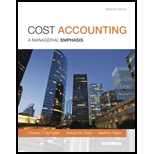
1.
Pounds Efficiency Variance:
Pounds efficiency variance is the distinction between the actual volumes of pounds failed less the budgeted quantity of pounds failed for a particular level of production.
Hours Variance:
Hours variance is the distinction between the actual rate of hours per pound and budgeted rate of hours per pound multiplied by the actual volume of pounds inspected.
Inverse Efficiency Variance:
Inverse efficiency variance is the distinction between the actual quantity of pounds for an output level and the budgeted quantity of pounds needed for the given output level multiplied by the budgeted rate of time.
To compute: Variances that determine the time spent on inspection was more or less than expected.
2.
To compute: Variances to evaluate the percentage of the food that fails the inspection.
Want to see the full answer?
Check out a sample textbook solution
Chapter 8 Solutions
Cost Accounting (15th Edition)
- Please explain the solution to this general accounting problem using the correct accounting principles.arrow_forwardWhat is the direct labor rate variance ?arrow_forwardChalamet Co. sold office furniture costing $15,600 with accumulated depreciation of $12,400 for $2,900 cash. The entry to record the sale would include a gain or loss of what amount?arrow_forward
- I am searching for the correct answer to this general accounting problem with proper accounting rules.arrow_forwardThe fiscal 2023 financial statements for Orion Enterprises, Inc. report revenues of $18,450,000, and net operating profit after tax of $1,295,000. Net operating assets at the end of 2023 are $7,800,000, while the 2022 balance sheet reports net operating assets of $7,500,000. What is Orion Enterprises' 2023 net operating profit margin?arrow_forwardFinancial accountingarrow_forward

 AccountingAccountingISBN:9781337272094Author:WARREN, Carl S., Reeve, James M., Duchac, Jonathan E.Publisher:Cengage Learning,
AccountingAccountingISBN:9781337272094Author:WARREN, Carl S., Reeve, James M., Duchac, Jonathan E.Publisher:Cengage Learning, Accounting Information SystemsAccountingISBN:9781337619202Author:Hall, James A.Publisher:Cengage Learning,
Accounting Information SystemsAccountingISBN:9781337619202Author:Hall, James A.Publisher:Cengage Learning, Horngren's Cost Accounting: A Managerial Emphasis...AccountingISBN:9780134475585Author:Srikant M. Datar, Madhav V. RajanPublisher:PEARSON
Horngren's Cost Accounting: A Managerial Emphasis...AccountingISBN:9780134475585Author:Srikant M. Datar, Madhav V. RajanPublisher:PEARSON Intermediate AccountingAccountingISBN:9781259722660Author:J. David Spiceland, Mark W. Nelson, Wayne M ThomasPublisher:McGraw-Hill Education
Intermediate AccountingAccountingISBN:9781259722660Author:J. David Spiceland, Mark W. Nelson, Wayne M ThomasPublisher:McGraw-Hill Education Financial and Managerial AccountingAccountingISBN:9781259726705Author:John J Wild, Ken W. Shaw, Barbara Chiappetta Fundamental Accounting PrinciplesPublisher:McGraw-Hill Education
Financial and Managerial AccountingAccountingISBN:9781259726705Author:John J Wild, Ken W. Shaw, Barbara Chiappetta Fundamental Accounting PrinciplesPublisher:McGraw-Hill Education





